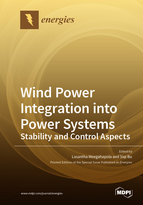Wind Power Integration into Power Systems: Stability and Control Aspects
A special issue of Energies (ISSN 1996-1073). This special issue belongs to the section "A3: Wind, Wave and Tidal Energy".
Deadline for manuscript submissions: closed (31 January 2021) | Viewed by 33363
Special Issue Editors
Interests: power system stability with wind integration to power systems; power plant modelling and simulation; microgrid stability and control
Special Issues, Collections and Topics in MDPI journals
Interests: power system modelling; stability analysis and control; power system planning and operation; grid integration of onshore/offshore wind power generation; VSC/LCC-HVDC system and FACTS/ESS/VSG technology utilisation; plug-in electric vehicle applications
Special Issue Information
Dear Colleagues,
Power network operators are rapidly embracing wind power generation into their power grids to meet the renewable energy targets in power generation. With this substantially increased wind power generation, significantly high instantaneous wind power penetration levels have been reported recently in the power networks of many countries and regions (e.g., Germany, Denmark, Ireland, South Australia) while giving rise to complex power system stability and control issues. More specifically, the main stability issues pertinent to power systems with high wind power penetration are frequency stability, voltage stability, and oscillatory stability. Control techniques such as virtual/emulated inertia and damping controls can be developed to tackle these stability issues, and additional devices, such as energy storage systems, can also be deployed to mitigate the adverse impact of high wind power generation on various system stability problems.
In this context, the guest editors invite experts in this field to contribute original and unpublished papers to this Special Issue dealing with but not limited to the following research areas:
- Frequency stability analysis with high wind power penetration;
- Frequency regulation and virtual inertia schemes for low inertia power grids;
- Voltage stability analysis with high wind power penetration;
- Voltage management and control with high wind power penetration;
- Oscillatory stability analysis with wind power generation;
- Design and optimising energy storage systems for stability improvement;
- Ancillary services management techniques with high wind power generation;
- Application of artificial intelligence, and machine learning techniques for stability enhancement;
- Optimal system planning, scheduling and coordination techniques to enhance with high wind power generation.
We also highly recommend the submission of multimedia with each article as it significantly increases the visibility, downloads, and citations of articles.
Dr. Lasantha Meegahapola
Dr. Siqi Bu
Guest Editors
Manuscript Submission Information
Manuscripts should be submitted online at www.mdpi.com by registering and logging in to this website. Once you are registered, click here to go to the submission form. Manuscripts can be submitted until the deadline. All submissions that pass pre-check are peer-reviewed. Accepted papers will be published continuously in the journal (as soon as accepted) and will be listed together on the special issue website. Research articles, review articles as well as short communications are invited. For planned papers, a title and short abstract (about 100 words) can be sent to the Editorial Office for announcement on this website.
Submitted manuscripts should not have been published previously, nor be under consideration for publication elsewhere (except conference proceedings papers). All manuscripts are thoroughly refereed through a single-blind peer-review process. A guide for authors and other relevant information for submission of manuscripts is available on the Instructions for Authors page. Energies is an international peer-reviewed open access semimonthly journal published by MDPI.
Please visit the Instructions for Authors page before submitting a manuscript. The Article Processing Charge (APC) for publication in this open access journal is 2600 CHF (Swiss Francs). Submitted papers should be well formatted and use good English. Authors may use MDPI's English editing service prior to publication or during author revisions.
Keywords
- power systems
- power electronics
- renewable energy
- energy storage
- power system control and operation







